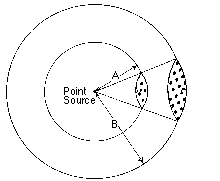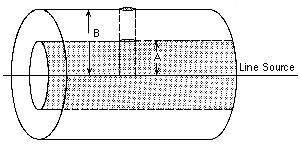The TRANSMISSION of acoustic energy through a medium via a SOUND WAVE.
See: SOUND, SPEED OF SOUND. Compare: ACOUSTIC RADIATION.
The levels of outdoor NOISE, whether they are intrusive or the normal background environment, vary extensively at distances greater than about a hundred meters from the source. This variation is caused by changes in weather conditions and by topographical features such as ground cover, hills and other obstacles between the source and the receiver.
There are several important factors which affect the propagation of sound: geometric spreading, atmospheric effects, and surface effects. These are discussed separately below.
1. Geometric Spreading
This refers to the spreading of sound energy as a result of the expansion of the wavefronts. Geometric spreading is independent of FREQUENCY and has a major effect in almost all sound propagation situations. There are two common kinds of geometric spreading: spherical and cylindrical spreading. Sound propagation losses due to spreading are normally expressed in terms of x dB per doubling of distance from the source. See: FREE FIELD, SIMPLE SOUND SOURCE.
For example, in the case of spherical spreading from a point source, which is due to a noise source radiating sound equally in all directions, the sound level is reduced by 6 dB for each doubling of distance from the source (see INVERSE-SQUARE LAW). A busy highway approximates to a line source, that is, equal sound power output per unit length of highway. A line source will produce cylindrical spreading, resulting in a sound level reduction of 3 dB per doubling of distance. See: SOUND TRANSMISSION LOSS.
2. Atmospheric Effects
(a) Air Absorption: There are two mechanisms by which acoustic energy is absorbed by the atmosphere. These are molecular relaxation and viscosity effects. By far the most important of these is molecular relaxation. High frequencies are absorbed more than low. The amount of ABSORPTION depends on the temperature and humidity of the atmosphere. The figures show the variation of the absorption with temperature and relative humidity.
From the diagrams it can be seen that for the middle of the speech frequency range (2 kHz), the absorption is typically .25 dB/100 m for 30% relative humidity and 20°C (68°F). It should be noted, however, it can be as high as 5 dB/100 m at 8 kHz when the temperature is 20°C and the humidity is 10%.
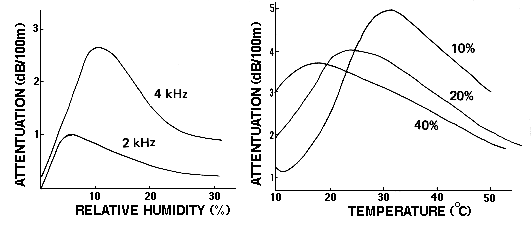
(left) Frequency dependence of attenuation as a function of relative humidity at 20°C.(right) Attenuation as a function of temperature for various percentages of relative humidity.
Precipitation, rain, snow, or fog, has an insignificant effect on sound levels although the presence of precipitation will obviously affect the humidity and may also affect wind and temperature gradients (see next section).
Under 'normal' circumstances, atmospheric absorption can be neglected except where long distances or very high frequencies are involved.
Ref.: Cyril Harris, "Absorption of Sound in Air versus Humidity and Temperature," Journal of the Acoustical Society of America, 40, p. 148.
(b) Wind and Temperature Gradients: The speed that sound propagates in a gas depends on the temperature of the gas. Higher temperatures produce higher speeds of sound. Since the temperature of the atmosphere is not uniform there are local variations in the sound speed. For example, under normal conditions the atmosphere is cooler at higher altitudes. This results in sound waves being 'bent' upwards (see REFRACTION). This will result in the formation of a shadow zone, which is a region in which sound does not penetrate. In reality some sound will enter this zone due to scattering. Scattering occurs when sound waves are propagating through the atmosphere and meet a region of inhomogeneity (a local variation in sound speed or air density) and some of their energy is re-directed into many other directions. In environmental noise situations, scattering is caused by air turbulence, rough surfaces, and obstacles such as trees. The scattering of sound by rain, snow or fog at ordinary frequencies is insignificant.
Compare: DIFFUSION, SOUND SHADOW.
Under conditions of a temperature inversion (temperature increasing with increasing height), the sound waves will be refracted downwards, and therefore may be heard over larger distances. This frequently occurs in winter and at sundown. For instance, the Nine O'Clock Gun in Vancouver has been heard up to 45 miles away under the proper atmospheric conditions.
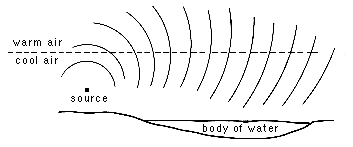
Refraction of sound waves by two layers of air at different temperatures as a result of the change of speed of the sound.
When a wind is blowing there will always be a wind gradient. This is due to the layer of air next to the ground being stationary. A wind gradient results in sound waves propagating upwind being 'bent' upwards and those propagating downwind being 'bent' downwards.
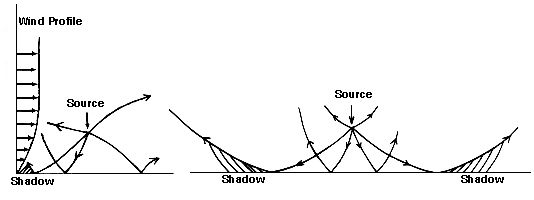
Temperature and wind gradients can result in measured sound levels being very different to those predicted from geometrical spreading and atmospheric absorption considerations alone. These differences may be as great as 20 dB. These effects are particularly important where sound is propagating over distances greater than a few hundred meters. Temperature inversions and winds can also result in the effectiveness of a barrier being dramatically reduced.
Ref.: Uno Ingard, "A Review of the Influence of Meteorological Conditions on Sound Propagation," Journal of the Acoustical Society of America, 25, p. 405.
(a) Ground Absorption: If sound is propagating over ground, ATTENUATION will occur due to acoustic energy losses on REFLECTION. These losses will depend on the surface. Smooth, hard surfaces will produce little ABSORPTION whereas thick grass may result in sound levels being reduced by up to about 10 dB per 100 meters at 2000 Hz. High frequencies are generally attenuated more than low frequencies. See: ACOUSTIC IMPEDANCE.
Reflection from the ground can result in another mechanism by which sound levels are reduced. When the source and receiver are both close to the ground, the sound wave reflected from the ground may interfere destructively with the direct wave. This effect (called the ground effect) is normally noticed over distances of several meters and more, and in the frequency range of 200-600 Hz. For the effect on spectrum, see PHASING.
See: CANCELLATION, INTERFERENCE.

Ref.: Wiener and Keast, "Experimental Study of the Propagation of Sound Over Ground," Journal of the Acoustical Society of America, 31, p. 724.
(b) Attenuation Due to Barriers and Trees: Research on propagation through trees has produced greatly conflicting results. It is clear, though, that trees are of more benefit aesthetically than acoustically. A band of trees several hundreds of feet deep is required in order to achieve significant attenuation.
Significant attenuation can be achieved by the use of solid barriers. A barrier should be at least high enough to obscure the 'line of sight' between the noise source and receiver. Barriers smaller than this may have a negative effect by elimination of the destructive INTERFERENCE phenomenon (see previous section). A barrier is most effective for high frequencies since low frequencies are diffracted around the edge of a barrier more easily (see DIFFRACTION). The maximum performance of a barrier is limited to about 40 dB, due to scattering by the atmosphere. A barrier is most effective when placed either very close to the source or to the receiver. It should be remembered that a barrier's performance can be severely reduced by temperature and wind gradients.
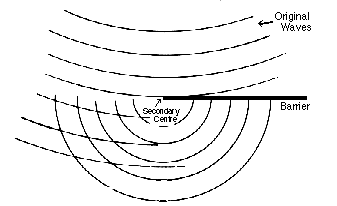
Diffraction of a low frequency sound wave around a barrier. Note that the barrier does not create a sound shadow in the area of the lower right-hand corner.
Barriers not built for acoustical purposes are often found in sound propagation situations. The most common of these are hills and buildings. In urban situations, buildings can be effective barriers. It is possible for buildings to produce a different acoustical effect. In a street, multiple reflections from parallel building facades can result in considerable reverberation, and consequently reduced attenuation. This is often referred to as the CANYON EFFECT.
Ref.: D. Aylor, "Noise Reduction by Vegetation and Ground", Journal of the Acoustical Society of America, 51, p. 197.
The importance of these various phenomena depends upon the situation under consideration. For example, for an aircraft on the ground and a receiver close by, only geometrical spreading and large obstacles (barriers) need be considered. If, on the other hand, the receiver is a large distance from the aircraft, then ground effects and atmospheric effects must be considered. If the aircraft is flying overhead, then only geometric spreading and atmospheric effects need be considered.
home
